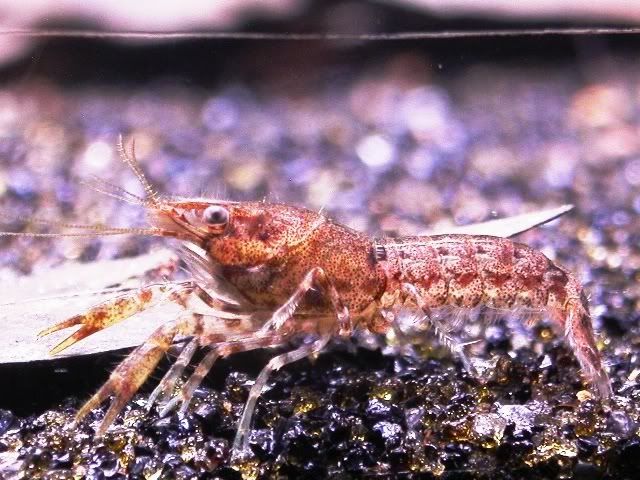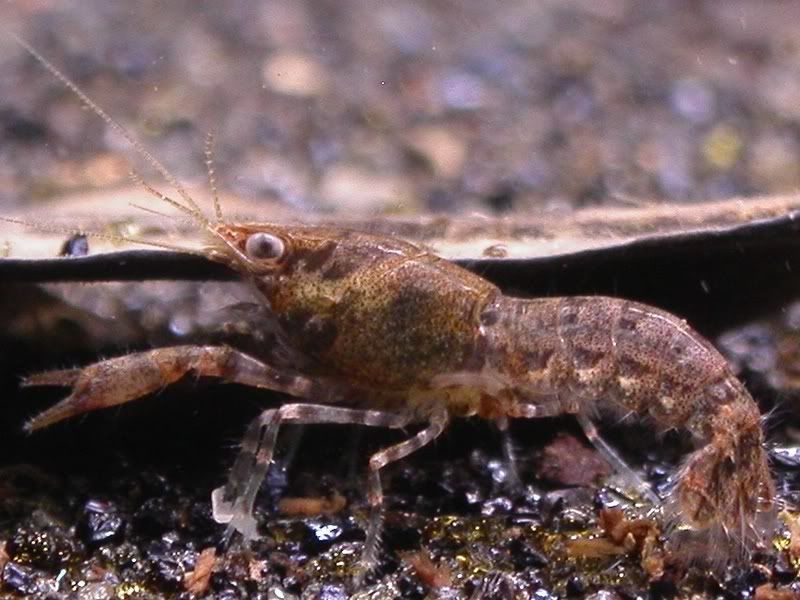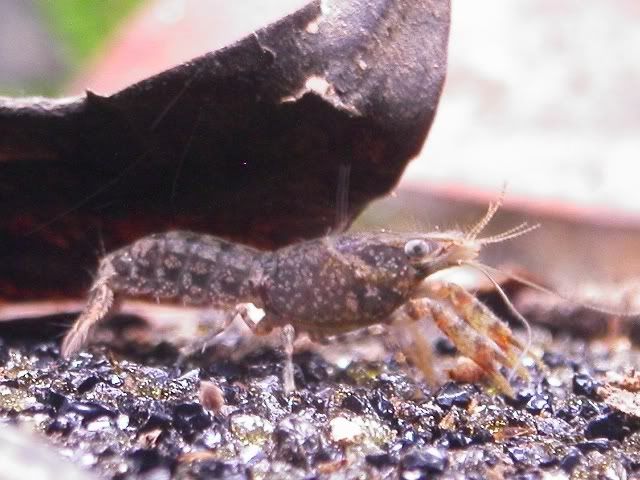Introducing: Cambarellus diminutus
Moderator: Mustafa
- YuccaPatrol
- Shrimp Master

- Posts: 600
- Joined: Sun Mar 12, 2006 4:41 pm
- Location: Burning-Ham, Alabama
Thanks everyone. The last one is my favorite because it is the only specimen that has an orange coloration (which does not show up so well in the photo).
It appears that it has both orange and a brown/olive coloration. I'm hoping that some selective breeding could increase the orange and remove the brown for a nice orange dwarf cray.
Hopefully I will get more photos of the darker color morphs tonight.
It appears that it has both orange and a brown/olive coloration. I'm hoping that some selective breeding could increase the orange and remove the brown for a nice orange dwarf cray.
Hopefully I will get more photos of the darker color morphs tonight.
- The Fisherman
- Shrimpoholic

- Posts: 380
- Joined: Thu Sep 07, 2006 12:49 pm
- Location: G.R. Michigan
- Contact:
- YuccaPatrol
- Shrimp Master

- Posts: 600
- Joined: Sun Mar 12, 2006 4:41 pm
- Location: Burning-Ham, Alabama
They were collected from two sites, but these sites are in the same stream system no more than a couple miles apart. I've been thinking about why they might exist with so much variation and my best guess has to do with their choice of habitat.Newjohn wrote:YuccaPatrol
That sure is alot of color variation.
Were they collected all in the same Area ?
John
They live among emergent aquatic plants at the shoreline of slow moving streams with sandy bottoms with dark colored leaf litter. Because their habitat is multicolored and because they are so small, there may not be a lot of natural selection for one or two preferred color morphs.
Wait until I get some photos of the dark ones. I'd guess that there are at least two to three times as many color morphs than I have been able to photograph.
edit: here is the best quality photo so far. . . .

- YuccaPatrol
- Shrimp Master

- Posts: 600
- Joined: Sun Mar 12, 2006 4:41 pm
- Location: Burning-Ham, Alabama
Thanks John, I really like taking the photos, and so I like posting them.
The "fuzz" is part of their sensory system. These could serve to sense vibrations or other stimuli. If you looked closely at larger species, you would see that that have the same "fuzz" too.
Here are a few more from tonight of some of the darker colors:


There are still few more shades of grey and brown that I need to catch
The "fuzz" is part of their sensory system. These could serve to sense vibrations or other stimuli. If you looked closely at larger species, you would see that that have the same "fuzz" too.
Here are a few more from tonight of some of the darker colors:


There are still few more shades of grey and brown that I need to catch
- Neonshrimp
- Master Shrimp Nut

- Posts: 2296
- Joined: Wed May 24, 2006 5:37 pm
- Location: California, USA
- YuccaPatrol
- Shrimp Master

- Posts: 600
- Joined: Sun Mar 12, 2006 4:41 pm
- Location: Burning-Ham, Alabama
- ToddnBecka
- Shrimpoholic

- Posts: 363
- Joined: Wed May 24, 2006 11:12 pm
- Location: Western Maryland
- YuccaPatrol
- Shrimp Master

- Posts: 600
- Joined: Sun Mar 12, 2006 4:41 pm
- Location: Burning-Ham, Alabama
I can't give a definitive answer, but I can share a few bits of information I have found in the scientific literature that might be relevant to the question.ToddnBecka wrote:Would different species of Cambarellus be likley to interbreed?
First, crayfish are usually identified based on the shape of the first pleopod of the male. The shape of this varies greatly and there could be some physical incompatibility between species that would prevent hybridization. No guarantee though.
Second, I have read several papers which mentioned that C. shufeldtii co-exists with C. diminutus and C. puer in some waterways. I have found no mention of hybridization, but one paper discussed how C. shufeldtii has extended its range at the expense of the other two through competition.
Third, the genus Cambarellus has been divided into 3 groups (sub-genus). There is one group composed of the Mexican species, another composed of only c. shufeldtii, and the last contains all other species found in the U.S. Hybridization would be more likley to occur within one of those groups than between groups. However, these groups are assigned by scientists based only on visible anatomical differences and geography/geology.
Last edited by YuccaPatrol on Sat Sep 30, 2006 7:28 pm, edited 1 time in total.
- ToddnBecka
- Shrimpoholic

- Posts: 363
- Joined: Wed May 24, 2006 11:12 pm
- Location: Western Maryland
The anatomical differences are visible, but I would imagine the pheromones would be different as well. I was wondering whether it would be wise to house different species of dwarf crayfish together, more specifically Mexican and North American species?
I was thinking pairs of different species may be easier to keep together in a small tank than several pairs of a single species.
If they wouldn't interbreed, would there be less conflict among males?
Would one species attack the other?
Or does it depend more on available space/territory requirements?
I am more familiar with cichlids than crayfish, but there seem to be parallel factors involved with both.
I'm trying to understand how crayfish react to different species, as opposed to conspecifics.
Cichlids are pretty simple: if it isn't their own species, and too big to eat, successful cohabitation is mainly dependent on space and territory.
I was thinking pairs of different species may be easier to keep together in a small tank than several pairs of a single species.
If they wouldn't interbreed, would there be less conflict among males?
Would one species attack the other?
Or does it depend more on available space/territory requirements?
I am more familiar with cichlids than crayfish, but there seem to be parallel factors involved with both.
I'm trying to understand how crayfish react to different species, as opposed to conspecifics.
Cichlids are pretty simple: if it isn't their own species, and too big to eat, successful cohabitation is mainly dependent on space and territory.
- YuccaPatrol
- Shrimp Master

- Posts: 600
- Joined: Sun Mar 12, 2006 4:41 pm
- Location: Burning-Ham, Alabama
I'll break down all of the species by subgenus:Newjohn wrote:
How many Mexican Species are there ?
9 species in the Cambarellus sub-genus from Mexico:
Cambarellus (Cambarellus) alvarezi
Cambarellus (Cambarellus) areolatus
Cambarellus (Cambarellus) chapalanus
Cambarellus (Cambarellus) chihuahuae
Cambarellus (Cambarellus) montezumae
Cambarellus (Cambarellus) occidentalis
Cambarellus (Cambarellus) patzcuarensis
Cambarellus (Cambarellus) prolixus
Cambarellus (Cambarellus) zempoalensis
1 species in the Dirigicambarus sub-genus from the U.S.:
Cambarellus (Dirigicamberus) shufeldtii
7 species in the Pandicambarellus sub-genus from the U.S.:
Cambarellus (Pandicambarus) blacki
Cambarellus (Pandicambarus) diminutus
Cambarellus (Pandicambarus) lesliei
Cambarellus (Pandicambarus) ninae
Cambarellus (Pandicambarus) puer
Cambarellus (Pandicambarus) schmitti
Cambarellus (Pandicambarus) texanus
- The Fisherman
- Shrimpoholic

- Posts: 380
- Joined: Thu Sep 07, 2006 12:49 pm
- Location: G.R. Michigan
- Contact:
